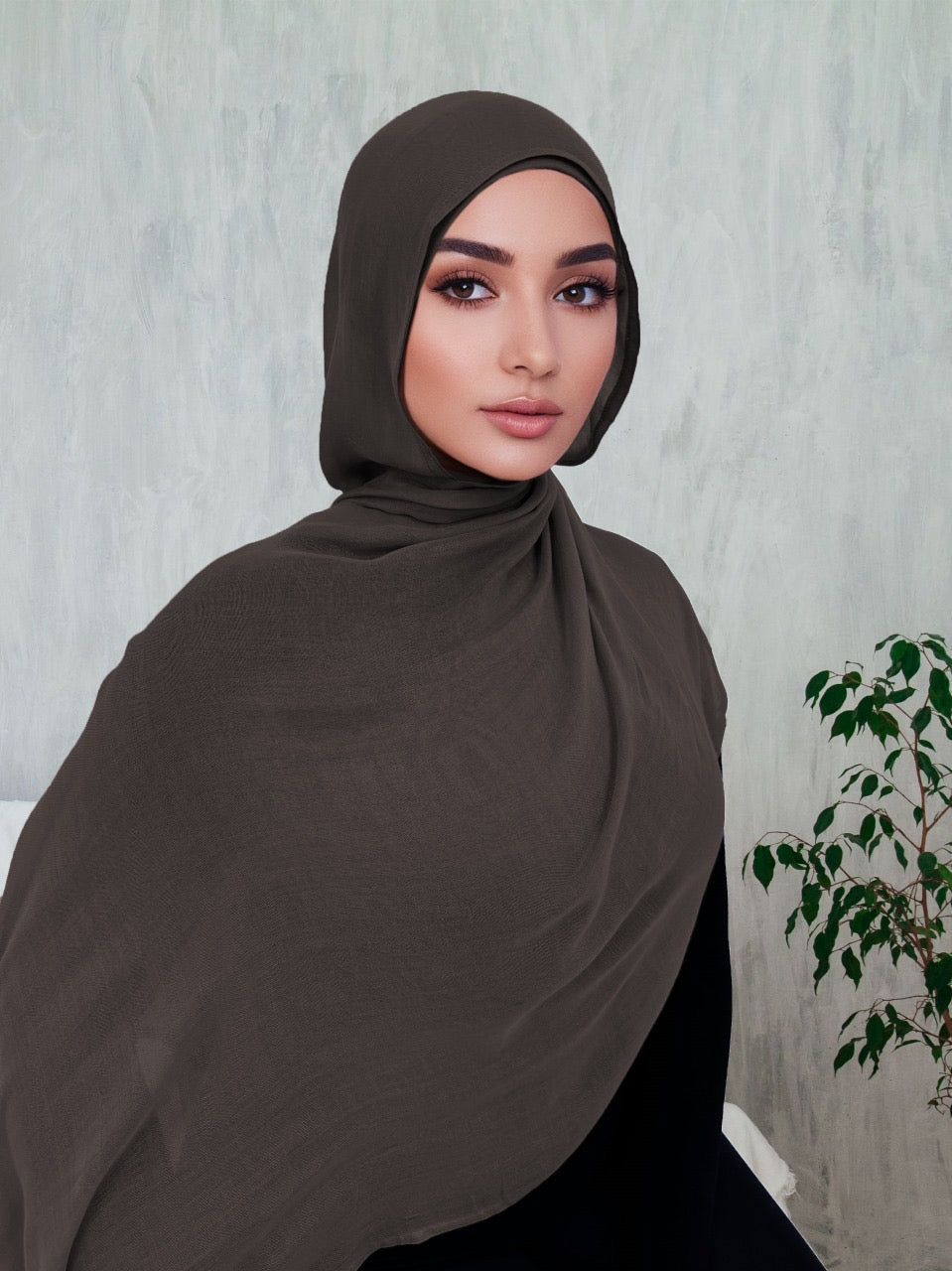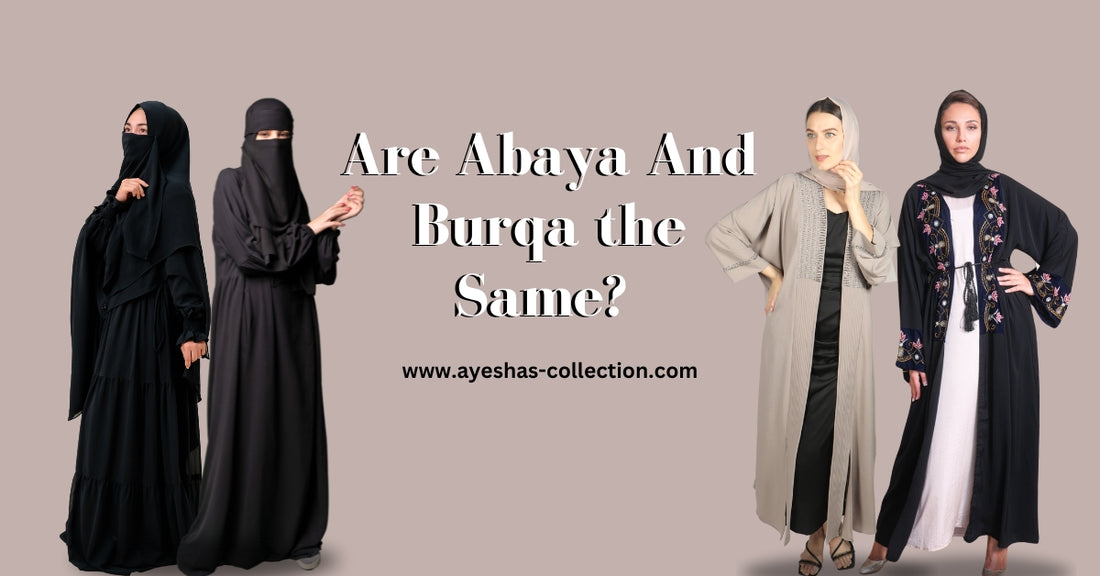No, abayas and burqas are not the same. An abaya is a cloak, while a burqa covers the entire body.
The cultural significance and diversity of Islamic attire is important for appreciating the distinctiveness of both the abaya and the burqa. These garments embody more than just clothing choices. They reflect a rich tapestry of traditions, values, and personal expressions.
The abaya, typically a long, flowing robe-like dress, serves as a modest yet fashionable outer garment for many women in various Islamic cultures. Contrarily, the burqa provides complete coverage, including the face, distinguishing it from other forms of Islamic dress. It stands as a symbol of commitment to certain interpretations of modesty in Islamic regions. Recognizing the differences between an abaya and a burqa aids in developing a deeper respect for the customs and choices of Muslim women worldwide.
The Essence Of Islamic Attire
Exploring the essence of Islamic attire reveals a tapestry of cultural and religious significance. Traditional garments like the abaya and burqa serve distinct purposes.
While both fulfill modesty requirements, their designs differ vastly. Understanding these outfits illuminates Islam's influence on fashion.
Cultural Significance
Across Islamic nations, attire transforms into a cultural beacon. Distinct patterns, fabrics, and accessories celebrate heritage.
- Abayas, often seen in the Gulf, showcase elegant simplicity.
- Intricate embroidery may hint at regional styles.
- The burqa reflects conservative values prevalent in certain societies.
Each holds a story, an ancestral whisper of community identities.
Religious Foundations
The tenets of Islam guide the faithful towards modesty. Abayas and burqas symbolize this devotional practice.
- Scriptural texts cite modest dress as a marker of piety.
- An abaya's loose fit ensures minimal attention, aligning with Islamic virtues.
- Burqas offer a cloak of anonymity, a deeper layer of modesty.
These garments bond wearers to their spiritual commitments, reflecting their dedication to faith.
Abaya

As we embark on a journey to decode the abaya, let us first recognize its uniqueness. This traditional cloak, worn by women in many parts of the Muslim world, is often misunderstood as being synonymous with the burqa. However, the abaya has its own distinct features, history, and cultural significance.
Design And Styles
Abayas come in various designs and styles, catering to personal tastes and cultural influences. Every abaya tells a story, a blend of tradition and modernity woven into one piece. Let's explore the diverse world of abaya fashion.
- Classic Black Abayas: A staple in many wardrobes, offering elegance and simplicity.
- Embellished Abayas: Adorned with embroidery, beads, or crystals, they add a touch of glamor.
- Contemporary Cuts: Think asymmetrical lines and unconventional silhouettes, perfect for the fashion-forward.
- Colorful Variants: Bold colors and prints break the monochrome and invite diversity.
Regional Variations
The abaya does not conform to a single mold. Its design and style are influenced by local customs and climatic conditions. This results in beautiful regional adaptations.
|
Region |
Style |
Distinguishing Features |
|
Gulf States |
Flowing, black, often with intricate embroidery. |
|
|
Morocco |
Takchita |
Two-layered, colorful, with a belt. |
|
Egypt |
Galabeya |
Looser fit, lighter fabrics, practical for daily wear. |
|
Levant |
Contemporary designs, often paired with jeans or pants. |
In essence, the abaya reflects the wearer's identity, preferences, and regional ethos. With every fold and drape, it narrates a story broader than just a piece of clothing.
The Burqa

Understanding the Burqa involves diving deep into its unique characteristics.
The Full-cover Feature
The burqa stands out for its complete coverage of the body. This outfit leaves no part of the body visible to the public eye. It consists of a loose fabric overlay that extends from head to toe. A mesh screen or grille allows the wearer to see while keeping the face hidden.
Geographical Prevalence
While the burqa connects with various cultures, its dominant presence is prominent in specific regions. Countries like Afghanistan and Pakistan have a high rate of burqa usage. It's also seen in parts of the Middle East and has cultural significance in Islamic traditions.
|
Region |
Burqa Usage |
|
Afghanistan |
Widely used |
|
Pakistan |
Common |
|
Middle East |
Varying rates |
Comparing Abaya And Burqa
The abaya and the burqa. Understanding these traditional attire pieces is essential. Each carries rich cultural significance and unique qualities.
Similarities In Purpose
The abaya and burqa share similar purposes. Both provide modesty according to cultural and religious practices.
- Modesty: Each garment ensures the wearer's modesty.
- Cultural significance: They are rooted in Islamic traditions.
- Personal choice: Many women choose these garments willingly.
Differences In Appearance
While serving similar functions, the abaya and burqa differ notably in design:
|
Garment |
Coverage |
Visibility |
|
Body minus the face, feet, and hands |
Face remains visible |
|
|
Burqa |
Entire body, including the face |
Mesh screen allows limited visibility |
The abaya is a long, flowing robe worn over clothing. It leaves the face, hands, and feet visible. Conversely, the burqa covers the whole body. A mesh screen over the eyes allows for sight.
Misconceptions And Clarifications
The media sometimes inaccurately portrays Islamic attire. Bold distinctions between an abaya and a burqa often get blurred. In truth, each serves a different purpose and reflects unique cultural aspects. News coverage can skew perceptions, leading to a uniform view of diverse customs across various regions.
- Abaya: A loose-fitting robe worn by some women in parts of the Muslim world.
- Burqa: An outer garment covering the entire body with a mesh screen to see through.
Public Perception And Realities
How society views Islamic wear affects individuals' experiences. People often interpret the abaya and burqa as identical, but that's not the case. Each garment has its own identity and tradition.
Here's a brief comparison to help elucidate:
|
Garment |
Description |
|
Abaya |
A long, elegant cloak that allows for personal style expression. |
|
Burqa |
A full-body veil that prioritizes privacy and religious beliefs. |
Society often misjudges these garments' purpose. Some see restrictions; others respect cultural significance. Let's bridge the gap through education and open dialogue.
Fashion

The Abaya and Burqa have deep cultural roots.
Modern Interpretations
Fashion adapts traditional attire to modern trends. Designers blend heritage with contemporary styles.
The Abaya has seen substantial transformation. It is not just a modest covering now.
Silhouettes are sleeker. Fabrics vary widely. From silk to denim, the options are endless.
Colors now burst forth. Black remains classic, but hues now range across the spectrum.
Embellishments and embroidery add glam. They make each piece unique.
Wearers express their personality through these clothes. The Abaya is now a fashion statement.
International Fashion Scene
The global stage has embraced the Abaya and Burqa. They have shifted from religious attire to high fashion.
Runways showcase them with a twist. Celebrities have been spotted wearing them.
Fashionistas look for cross-cultural influences. Such garments are now part of the global trend.
Diverse materials make them suitable for various climates.
Their reach has spread. From the Middle East to Europe and America, their impact is felt.
Designers incorporate traditional elements into mainstream fashion. They cater to a broad audience.
Thus, these pieces remain relevant. They honor culture while riding the fashion wave.
|
Traditional |
Modern Fashion |
|
Classic black Abaya |
Colored and patterned designs |
|
Simple fabrics |
Luxurious materials |
|
Functional wear |
Designer and bespoke pieces |
Personal Stories And Experiences
At Ayesha's Collection, many of our customers often confuse the abaya with the burqa. We explain to them that these are both traditional Islamic dresses. Among them we hear some stories of abaya and burka. For example:
Voices from within the community
Ayesha from Riyadh: "My abaya is a part of my identity."
Laila from Cairo: "In my burqa, I find freedom."
Sarah from Dubai: "My abaya gives me elegance."
These narratives reveal the role of the abaya as a cultural symbol. They also show the function of the burqa as a shield of privacy.
The Western Perspective
Western views on these garments can differ. Misunderstandings are common.
|
Term |
Perception |
|
Abaya |
Seen as a fashion statement by some |
|
Burqa |
Often viewed as a sign of oppression |
Yet, there is growing awareness. Many now recognize these garments as elements of cultural expression.
Conclusion
Understanding the distinctions between the abaya and burqa is essential. Each garment reflects cultural and personal choices, carrying deep significance. While sharing modesty as a common thread, their designs set them apart. Our exploration reveals that clarity around traditional attire enhances cultural respect and knowledge.
Frequently Asked Questions
What Is Another Name For Burka?
Another term for a burka is "hijab," which can also refer to various types of Islamic veils.
Is Abaya Haram In Islam?
No, abaya is not haram in Islam. It is often worn as a modest garment that aligns with Islamic dress code guidelines.
What Is The Arabic Name For Abaya?
The Arabic word for abaya is "عباية," pronounced as "ʿabāyah. "
Is It Abaya Or Niqab?
An abaya is a full-length, flowing garment typically worn by Muslim women. A niqab is a facial veil that covers the face, leaving only the eyes visible.


